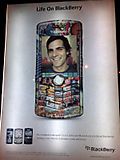Regular readers of this blog probably know that I am a glowing Opera Mini fan. I am amazed at how versatile this piece of software is for mobile web browsing. Here are two tips of how to extend the functionality which have come in pretty handy recently:
- Delicous bookmarklet: Opera Mini fans also using the Opera desktop browser are probably pretty happy with the mobile/desktop bookmark synchronization feature. Since I use Firefox and Delicious, I'd like to have a similar feature, as sending links I have found by eMail is a bit too complicated to be efficient. Almost as easy said as done. Denis over from Wap Review has found out how to add a Delicious bookmarklet to the Opera Mini bookmarks. He actually posted the tip over one and a half years ago. Thanks Goolge for pointing me there. Works great, thanks Denis!
- Google Reader: I used to read my feeds via Thunderbird which had the big disadvantage that more often than not, I failed to keep up to the flow of information as I just did not have time to attend my blog roll in front of a computer. I usually have a couple of minutes to spare when I am mobile though. So I switched to Google Reader, which has both a superb desktop and mobile interface. First, I tried the iPhone mobile interface in the S60 browser. It works great, but the missing up/down page scroll functionality of the S60 browser makes it too awkward to use. Nokia, how much longer do we have to wait for this simple functionality? In the meantime, I use the standard mobile interface, which works well with Opera Mini. It doesn't look as nice as the iPhone web interface, but it does its job superbly.


